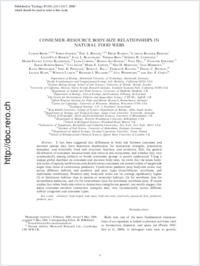Consumer-resource body-size relationships in natural food webs
- Brose, Ulrich Department of Biology, Darmstadt University of Technology, Germany - Pacific Ecoinformatics and Computational Ecology Lab, Berkeley, USA -
- Jonsson, Tomas Systems Biology Group, School of Life Sciences, University of Skövde, Sweden
- Berlow, Eric L. Department of Biology, Darmstadt University of Technology, Germany - Pacific Ecoinformatics and Computational Ecology Lab, Berkeley, USA - University of California, Merced, Sierra Nevada Research Institute, Yosemite National Park, USA
- Warren, Philip Department of Animal and Plant Sciences, University of Sheffield, UK
- Banasek-Richter, Carolin Department of Biology, Darmstadt University of Technology, Germany
- Bersier, Louis-Félix Department of Biology, Unit of Ecology and Evolution, University of Fribourg, Switzerland
- Blanchard, Julia L. The Centre for Environment, Fisheries and Aquaculture Science, Suffolk, UK
- Brey, Thomas Alfred Wegener Institute for Polar and Marine Research, Bremerhaven, Germany
- Carpenter, Stephen R. Center for Limnology, University of Wisconsin, Madison, USA
- Blandenier, Marie-France Cattin Zoological Institute, University of Neuchâtel, Switzerland
- Cushing, Lara Pacific Ecoinformatics and Computational Ecology Lab, Berkeley, USA
- Dawah, Hassan Ali King Khalid University, College of Science, Department of Biology, Abha, Saudi Arabia
- Dell, Tony Department of Zoology and Tropical Ecology, James Cook University, Townsville, Australia
- Edwards, Francois School of Geography, Earth and Environmental Sciences, University of Birmingham, UK
- Harper-Smith, Sarah Department of Biology, Western Washington University, Bellingham, USA
- Jacob, Ute Alfred Wegener Institute for Polar and Marine Research, Bremerhaven, Germany
- Ledger, Mark E. School of Geography, Earth and Environmental Sciences, University of Birmingham, UK
- Martinez, Neo D. Pacific Ecoinformatics and Computational Ecology Lab, Berkeley, USA
- Memmott, Jane School of Biological Sciences, Woodland Road, Bristol, UK
- Mintenbeck, Katja Alfred Wegener Institute for Polar and Marine Research, Bremerhaven, Germany
- Pinnegar, John K. The Centre for Environment, Fisheries and Aquaculture Science, Suffolk, UK
- Rall, Björn C. Department of Biology, Darmstadt University of Technology, Germany
- Rayner, Thomas S. Department of Zoology and Tropical Ecology, James Cook University, Townsville, Australia
- Reuman, Daniel C. Laboratory of Populations, Rockefeller and Columbia Universities, New York, USA
- Ruess, Liliane Institute of Soil Science, University of Hohenheim, Stuttgart, Germany
- Ulrich, Werner Department of Animal Ecology, Nicolaus Copernicus University, Torun, Poland
- Williams, Richard J. Pacific Ecoinformatics and Computational Ecology Lab, Berkeley, USA -
- Woodward, Guy School of Biological and Chemical Sciences, Queen Mary University of London, UK
- Cohen, Joel E. Laboratory of Populations, Rockefeller and Columbia Universities, New York, USA
-
2006
Published in:
- Ecology. - 2006, vol. 87, no. 10, p. 2411-2417
English
It has been suggested that differences in body size between consumer and resource species may have important implications for interaction strengths, population dynamics, and eventually food web structure, function, and evolution. Still, the general distribution of consumer–resource body-size ratios in real ecosystems, and whether they vary systematically among habitats or broad taxonomic groups, is poorly understood. Using a unique global database on consumer and resource body sizes, we show that the mean body-size ratios of aquatic herbivorous and detritivorous consumers are several orders of magnitude larger than those of carnivorous predators. Carnivorous predator–prey body-size ratios vary across different habitats and predator and prey types (invertebrates, ectotherm, and endotherm vertebrates). Predator–prey body-size ratios are on average significantly higher (1) in freshwater habitats than in marine or terrestrial habitats, (2) for vertebrate than for invertebrate predators, and (3) for invertebrate than for ectotherm vertebrate prey. If recent studies that relate body-size ratios to interaction strengths are general, our results suggest that mean consumer–resource interaction strengths may vary systematically across different habitat categories and consumer types.
- Faculty
- Faculté des sciences et de médecine
- Department
- Département de Biologie
- Language
-
- English
- Classification
- Biological sciences
- License
-
License undefined
- Identifiers
-
- RERO DOC 12581
- DOI 10.1890/0012-9658(2006)87
- Persistent URL
- https://folia.unifr.ch/unifr/documents/301398
Statistics
Document views: 175
File downloads:
- pdf: 288
